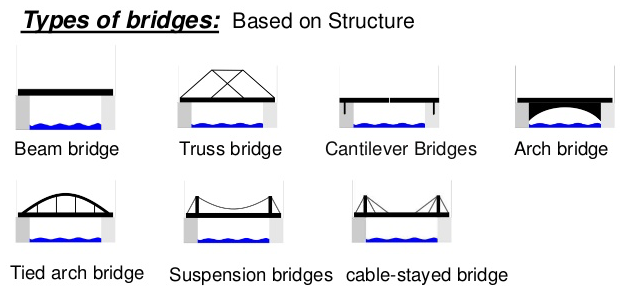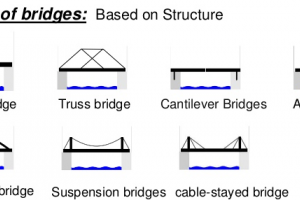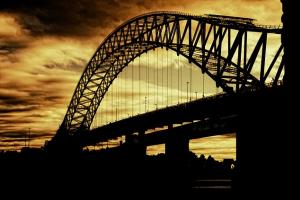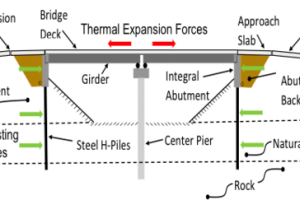Types of Bridges - Bridge Types Arch, Girder, Cable, Truss, Rigid Frame

Types of Bridges
Below is the list of 5 main types of bridges based on support mechanism:
- Girder bridges
- Arch bridges
- Cable-stayed bridges
- Rigid Frame Bridges
- Truss bridges
1. Girder bridges:
It is the most common and most basic bridge type. In its simplest form, a log across a creek is an example of a girder bridge; the two most common girders are I-beam girders and box-girders used in steel girder bridges. Examining the cross section of the I-Beam speaks for its so name. The vertical plate in the middle is known as the web, and the top and bottom plates are referred to as flanges.
A box girder takes the shape of a box. The typical box girder has two webs and two flanges. However, in some cases there are more than two webs, creating a multiple chamber box girder. Other examples of simple girders include pi girders, named for their likeness to the mathematical symbol for pi, and T shaped girders. Since the majority of girder bridges these days are built with box or I-beam girders we will skip the specifics of these rarer cases.
![]() Watch Bridge Engineering Videos & Tutorials
Watch Bridge Engineering Videos & Tutorials
An I-beam is very simple to design and build and works very well in most cases. However, if the bridge contains any curves, the beams become subject to twisting forces, also known as torque. The added second web in a box girder adds stability and increases resistance to twisting forces. This makes the box girder the ideal choice for bridges with any significant curve in them. Box girders, being more stable are also able to span greater distances and are often used for longer spans, where I-beams would not be sufficiently strong or stable. However, the design and fabrication of box girders is more difficult than that of I beam. For example, in order to weld the inside seams of a box girder, a human or welding robot must be able to operate inside the box girder.
2. Arch bridges:
Arch bridges are the types of bridges which pose a classic architecture and the oldest after the girder bridges. Unlike simple girder bridges, arches are well suited to the use of stone. Since the arch doesn’t require piers in the center so arches are good choices for crossing valleys and rivers. Arches can be one of the most beautiful bridge types. Arches use a curved structure which provides a high resistance to bending forces. Arches can only be used where the ground or foundation is solid and stable because unlike girder and truss bridges, both ends of an arch are fixed in the horizontal direction (i.e. no horizontal movement is allowed in the bearing). Thus, when a load is placed on the bridge (e.g. a car passes over it) horizontal forces occur in the bearings of the arch. Like the truss, the roadway may pass over or through an arch or in some cases.
Structurally there are four basic arch type bridges:
- Hinge-less
- Two-hinged
- Three hinged
- Tied arches
The hinge-less arch uses no hinges and allows no rotation at the foundations. As a result a great deal of force is generated at the foundation (horizontal, vertical, and bending forces) and the hinge-less arch can only be built where the ground is very stable. However, the hinge-less arch is a very stiff structure and suffers less deflection than other arches. The two hinged arch uses hinged bearings which allow rotation.
The only forces generated at the bearings are horizontal and vertical forces. This is perhaps the most commonly used variation for steel arches and is generally a very economical design. The three-hinged arch adds an additional hinge at the top or crown of the arch. The three-hinged arch suffers very little if there is movement in either foundation (due to earthquakes, sinking, etc.)
However, the three-hinged arch experiences much more deflection and the hinges are complex and can be difficult to fabricate. The three-hinged arch is rarely used anymore. The tied arch is a variation on the arch which allows construction even if the ground is not solid enough to deal with the horizontal forces. Rather than relying on the foundation to restrain the horizontal forces, the girder itself "ties" both ends of the arch together, thus the name "tied arch."
3. Cable stayed bridges:
Another type of bridge is the cable stayed bridge. A typical cable stayed bridge is a continuous girder with one or more towers erected above piers in the middle of the span. From these towers, cables stretch down diagonally (usually to both sides) and support the girder. Steel cables are extremely strong but very flexible. Cables are very economical as they allow a slender and lighter structure which is still able to span great distances. Though only a few cables are strong enough to support the entire bridge, their flexibility makes them weak to a force we rarely consider: the wind.
For longer span cable-stayed bridges, careful studies must be made to guarantee the stability of the cables and the bridge in the wind. The lighter weight of the bridge, though a disadvantage in a heavy wind, is an advantage during an earthquake. However, should uneven settling of the foundations occur during an earthquake or over time, the cable-stayed bridge can suffer damage so care must be taken in planning the foundations. The modern yet simple appearance of the cable-stayed bridge makes it an attractive and distinct landmark.
The unique properties of cables, and the structure as a whole, make the design of the bridge a very complex task. For longer spans where winds and temperatures must be considered, the calculations are extremely complex and would be virtually impossible without the aid of computers and computer analysis. The fabrication of cable stay bridges is also relatively difficult. The cable routing and attachments for the girders and towers are complex structures requiring precision fabrication. There are no distinct classifications for cable-stayed bridges.
However, they can distinguish by the number of spans, number of towers, girder type, number of cables, etc. There are many variations in the number and type of towers, as well as the number and arrangement of cables. Typical towers used are single, double, portal, or even A-shaped towers. Cable arrangements also vary greatly. Some typical varieties are mono, harp, fan, and star arrangements. In some cases, only the cables on one side of the tower are attached to the girder, the other side being anchored to a foundation or other counterweight.
4. Rigid frame bridges:
Rigid frame bridges are sometimes also known as Rahmen bridges. In a standard girder bridge type, the girder and the piers are separate structures. However, a rigid frame bridge is one in which the piers and girder are one solid structure.
The cross sections of the beams in a rigid frame bridge are usually I shaped or box shaped. Design calculations for rigid frame bridges are more difficult than those of simple girder bridges. The junction of the pier and the girder can be difficult to fabricate and requires accuracy and attention to detail.
Though there are many possible shapes, the styles used almost exclusively these days are the pi-shaped frame, the batter post frame, and the V shaped frame. The batter post rigid frame bridge is particularly well suited for river and valley crossings because piers tilted at an angle can straddle the crossing more effectively without requiring the construction of foundations in the middle of the river or piers in deep parts of a valley. V shaped frames make effective use of foundations. Each V-shaped pier provides two supports to the girder, reducing the number of foundations and creating a less cluttered profile. Pi shaped rigid frame structures are used frequently as the piers and supports for inner city highways. In these types of bridges the frame supports the raised highway and at the same time allows traffic to run directly under the bridge.
5. Truss bridges:
Of all the types of bridges, truss bridges are most common, usually in steel bridges. Trusses are comprised of many small beams that together can support a large amount of weight and span great distances. In most cases the design, fabrication, and erection of trusses is relatively simple. However, once assembled trusses take up a greater amount of space and, in more complex structures, can serve as a distraction to drivers. Like the girder bridges, there are both simple and continuous trusses.
The small size of individual parts of a truss make it the ideal bridge for places where large parts or sections cannot be shipped or where large cranes and heavy equipment cannot be used during erection. Because the truss is a hollow skeletal structure, the roadway may pass over or even through the structure allowing for clearance below the bridge often not possible with other bridge types. Trusses are also classified by the basic design used. The most representative trusses are the Warren truss, the Pratt truss, and the Howe truss. The Warren truss is perhaps the most common truss for both simple and continuous trusses. For smaller spans, no vertical members are used lending the structure a simple look.
For longer spans vertical members are added providing extra strength. Warren trusses are typically used in spans of between 50-100m. The Pratt truss is identified by its diagonal members which, except for the very end ones, all slant down and in toward the center of the span. Except for those diagonal members near the center, all the diagonal members are subject to tension forces only while the shorter vertical members handle the compressive forces. This allows for thinner diagonal members resulting in a more economic design. The Howe truss is the opposite of the Pratt truss. The diagonal members face in the opposite direction and handle compressive forces. This makes it very uneconomic design for steel bridges and its use is rarely seen.








